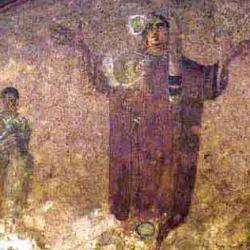In discussing the rise of “mysteriological liturgical piety” in the fourth century, Alexander Schmemann (Introduction to Liturgical Theology) emphasizes the increasing pomp and ceremony of the liturgy. Orthodox liturgist though he is, Schmemann doesn’t approve the development, as it emphasizes “exterior” rather than “interior” solemnity.
“Exterior solemnity,” he writes, “consists in the sacralization of sacred ceremonies and actions, in emphasizing that they are not ‘simple,’ in building around them an atmosphere of sacred and religious fear which cannot fail to influence the way they are received and experienced by the participants in the cult.” Early Christians denounced this sort of worship as pompa diabola, the very thing renounced in baptism (120).
Interior solemnity by contrast “lies in the fullness of religious meaning invested in an action, no matter how simple it may be: the breaking of bread, the lifting up the hands, etc.” Differently stated, interior solemnity “is the complete awareness and acceptance of this meaning by those who are performing the ceremony or who are present at it.” Inner solemnity requires faith that this little meal with this band of disciples is”the feast of the Kingdom” (120).
To Schmemann, “early Christian worship was profoundly solemn with an inner solemnity, and devoid of external solemnity.”
Schmemann, I repeat, was a Russian Orthodox theologian. He knows whereof he speaks, and offers a warning to liturgical enthusiasts of every age.











